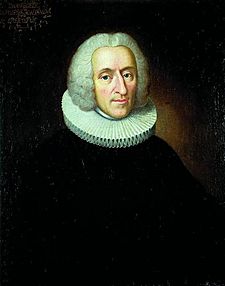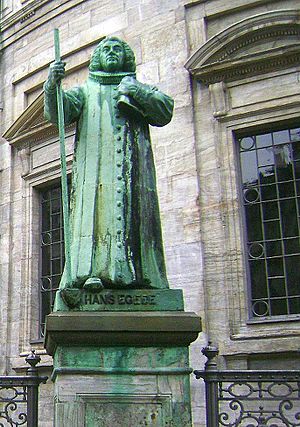Hans Egede facts for kids
Quick facts for kids Hans Egede |
|
 Johan Hörner, Hans Egede, c. 1745, Danish Museum of National History |
|
| Born | 31 January 1686 in Harstad, Denmark-Norway |
|---|---|
| Died | 5 November 1758 (age 72) in Falster, Denmark-Norway |
| Church | Church of Norway (evangelical Lutheran) |
| Writings | Published the journal of his journey to Greenland |
| Offices held |
|
| Title | National Saint of Greenland |
| Spouse | Gertrud Egede nee Rasch |
| Children |
|

Hans Poulsen Egede (born January 31, 1686 – died November 5, 1758) was a Lutheran missionary from Denmark–Norway. He started important missionary work in Greenland. Because of his efforts, he is often called the Apostle of Greenland.
Hans Egede successfully started a mission among the Inuit people. He also helped Denmark-Norway become interested in Greenland again. This happened after about 300 years with no contact. He founded Greenland's capital city, Godthåb, which is now known as Nuuk.
Contents
Early Life and Education
Hans Egede was born in Harstad, Norway. His father was a government worker. Harstad is about 150 miles north of the Arctic Circle. Hans was taught by his uncle, who was a church leader in the local Lutheran Church.
In 1704, Hans traveled to Copenhagen. He went to the University of Copenhagen and studied to become a pastor. After finishing his studies, he returned to Hinnøya Island. In 1707, he became a pastor and was sent to a church in Lofoten. That same year, he married Gertrud Rasch. They had four children together: two boys and two girls.
Journey to Greenland
While living in Lofoten, Hans Egede heard stories about old Viking settlements in Greenland. People had lost contact with these settlements centuries ago.
Starting in 1711, Egede asked King Frederick IV of Denmark-Norway for permission. He wanted to find the old settlements and start a mission there. He thought the people might still be Catholic or had lost their Christian faith. The King agreed, partly because he wanted Denmark-Norway to claim the island again.
Egede helped create the Bergen Greenland Company. This company gathered money from merchants and the King. It was given powers to manage Greenland, collect taxes, and make laws.
Arrival in Greenland
On May 2, 1721, Egede, his wife, their four children, and forty other settlers left Bergen. They sailed on a ship called Haabet ("The Hope") and two smaller ships. On July 3, they reached Nuup Kangerlua. They built a portable house on Kangeq Island and called their new home Hope Colony.
For months, Egede searched for descendants of the old Viking settlers. But he only found the local Kalaallit people. He then began to learn their language.
There is a common story that Egede changed the Lord's Prayer to "Give us this day our daily seal". This is a myth. Egede did try to find a word for "food" in the Inuit language. He first used "mamaq," which means "how delicious!" Later, he learned the correct word for "food," which is "neqissat." His son, Poul, later used the word "timiusaq" for bread. This word means "it which resembles bone marrow" and is still used today for wafers in church.
Challenges and Discoveries
The first winter was very hard. Many settlers got sick with scurvy, a serious illness. Most of them went back home as soon as they could. Egede and his family stayed with a few others. In 1722, two supply ships arrived, sent by the king.
Egede explored the western coast but found no Viking survivors. He mistakenly believed that the Eastern Settlement was on Greenland's east coast. In 1723, his expedition found the ruins of the Eastern Settlement. He also helped set up a whaling station on Nipisat Island. In 1724, he baptized his first Inuit converts. Some of these converts later traveled to Denmark.
In 1728, a royal expedition arrived and moved the colony to the mainland. They built a fort called Godt-Haab ("Good Hope"), which became Godthåb. More people died from scurvy, and many Danes and Inuit left the area.
Egede's book, The Old Greenland's New Perlustration, was published in 1729. It was translated into several languages. However, King Frederick decided to recall the soldiers from Greenland the next year. Egede, encouraged by his wife Gertrud, chose to stay with his family and ten sailors.
Later Years and Legacy
In 1733, a supply ship brought three missionaries. It also brought news that the king would support a new company for the colony. The Moravians were allowed to set up a station called Neu-Herrnhut. This place became the center of modern Nuuk.
The ship also brought one of Egede's convert children back to Greenland. This child had smallpox. By the next year, a terrible smallpox epidemic spread among the Inuit. In 1735, Egede's wife, Gertrud, died from the disease. Hans took her body back to Denmark for burial the next year. His son, Poul, continued his work in Greenland.
In Copenhagen, Hans Egede was made the head of the Greenland Mission Seminary. In 1741, he became the Lutheran Bishop of Greenland. He finished a catechism (a book of Christian teachings) for use in Greenland in 1747. He passed away on November 5, 1758, in Stubbekøbing, Denmark.
Remembering Hans Egede
Hans Egede is seen as a very important figure in Greenland. The town of Egedesminde ("Memory of Egede") is named after him. His second son, Niels, founded it in 1759. His grandson, Hans Egede Saabye, also became a missionary in Greenland.
The Royal Danish Geographical Society created the Egede Medal in his honor in 1916. This silver medal is given for geographical studies and research in the Arctic regions.
A crater on the Moon is named after him: the Egede crater.
Statues of Hans Egede stand in Greenland's capital, Nuuk, and outside Frederik's Church in Copenhagen. In 2020, his statues were spray-painted during protests. However, in Nuuk, people voted to keep his statue.
Hans Egede also gave one of the oldest descriptions of a sea serpent. On July 6, 1734, he wrote that his ship saw a "most terrible creature." He described its small head, wrinkled body, and giant fins. He said it was longer than his whole ship. Today, people believe this creature was likely a giant squid.
Gallery
-
1747 map based on Egede's descriptions, by Emanuel Bowen
-
Sea serpent reported by Hans Egede in 1734, probably a giant squid
See also
 In Spanish: Hans Egede para niños
In Spanish: Hans Egede para niños







